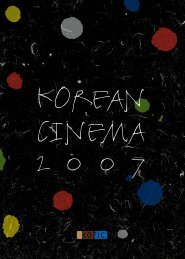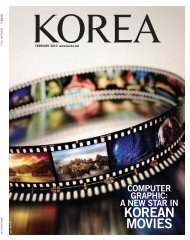My Impression of Korea - Korea.net
My Impression of Korea - Korea.net
My Impression of Korea - Korea.net
- No tags were found...
Create successful ePaper yourself
Turn your PDF publications into a flip-book with our unique Google optimized e-Paper software.
PEOPLE<br />
Yonhap<br />
Lim performs a traditional<br />
<strong>Korea</strong>n dance at the Shimogamo<br />
Shrine in Kyoto, Japan<br />
Kim Ki-duk’s<br />
‘Dream’ is<br />
Provocative,<br />
Deep<br />
BY YANG SUNG-JIN<br />
KOREA HERALD STAFF WRITER<br />
Director Kim Ki-duk<br />
Award-winning director Kim Ki-duk has built<br />
up an international reputation with his films<br />
that starkly differ from other mainstream<br />
movies in <strong>Korea</strong> and elsewhere. He stands<br />
out largely because <strong>of</strong> his provocative styles<br />
and thought-provoking themes.<br />
For better or worse, Kim did not pull any<br />
punches in making his 15th feature, “Dream<br />
(BiMong),” which was released here on Oct. 9.<br />
The movie has attracted media attention by<br />
signing up high-pr<strong>of</strong>ile actors — Lee Na-young<br />
from <strong>Korea</strong> and Joe Odagiri from Japan — but<br />
viewers should be aware <strong>of</strong> the cinematic puzzles<br />
director Kim routinely inserts in his films, if<br />
they want to grasp what is really going on in<br />
this mixture <strong>of</strong> reality and fantasy.<br />
Odagiri plays Jin, an artist who sees himself<br />
in a dream causing a car crash. What he discovers,<br />
however, is that his dream is not a<br />
mere creation <strong>of</strong> his brain — all the details he<br />
witnessed while sleeping turn out to be true.<br />
Or that’s what viewers are supposed to assume,<br />
given the quirky plot turns provided by<br />
director Kim, who never shies away from purposeful<br />
ambiguity and ambivalence.<br />
Jin encounters a woman named Ran (Lee<br />
Na-young), a character who has plenty <strong>of</strong><br />
grievances, especially concerning her shattered<br />
relationship with her ex-boyfriend.<br />
Strange as it may be, what Jin believes he has<br />
done in his dream is what Ran has done in reality.<br />
Although the car accident happens in<br />
Jin’s dream, the same incident plays out in<br />
Ran’s life, with police seeing her as the prime<br />
The poster for the film “Dream”<br />
suspect.<br />
The key proposition <strong>of</strong> the movie is that the<br />
two main characters are connected through<br />
dreams in a way that blurs reality and fantasy.<br />
A butterfly emerges as the core image symbolizing<br />
the significance <strong>of</strong> dreams. In fact,<br />
this metaphor comes from a well-known ancient<br />
Chinese thinker, and its implication is<br />
rather straightforward: A person may dream<br />
about his life and discover that it’s just a<br />
dream when he wakes up, but how can he be<br />
sure about the possibility that what appears<br />
as reality is also another dream?<br />
Kim’s presentation <strong>of</strong> the dream’s implications,<br />
however, is far from straightforward. The<br />
subplots are utterly confusing. Jin used to<br />
have a girlfriend, but the relationship is now<br />
over. But he finds himself dreaming about his<br />
former girlfriend and he vaguely senses that he<br />
still loves her. While Jin is struggling in his<br />
dreams, Ran is visiting her former boyfriend,<br />
not in her dream but while sleeping, because<br />
she is a sleepwalker. She hates the man<br />
deeply and when she realizes what she has<br />
done, she gets mad at Jin, the man whose<br />
dream goes in lockstep with her nightly visits.<br />
To resolve the situation, Jin and Ran attempt<br />
to do the almost impossible: stay awake<br />
all the time. The assumption is that if Jin does<br />
not sleep, Ran does not have to walk around in<br />
her sleep. Jin can also sleep without his muchdreaded<br />
dream that generates real events<br />
when Ran is awake.<br />
Their struggle to stay awake is, as some <strong>of</strong><br />
director Kim’s fans might correctly predict,<br />
depicted in a gruesome manner. Self-inflicted<br />
torture abounds, which will make the audience<br />
squirm.<br />
One hint regarding Kim’s message is the<br />
peculiar existence <strong>of</strong> Jin. Japanese actor<br />
Odagiri plays the role in Japanese, while all<br />
the other characters speak in <strong>Korea</strong>n.<br />
Strangely enough, Jin communicates perfectly<br />
with other <strong>Korea</strong>ns, even though he continues<br />
to speak in Japanese. His otherworldly<br />
identity that transcends the language barrier<br />
is certainly unrealistic, but Kim leaves more<br />
questions than answers about his new cinematic<br />
dreamland that is so desolate. ■<br />
<strong>Korea</strong>n Dance<br />
Performed at<br />
Japan’s Oldest Shrine<br />
BY LEE JI-YOON<br />
STAFF WRITER<br />
Lim Lee-jo, head <strong>of</strong> the Seoul Metropolitan Dance Theatre,<br />
captivated the eyes and minds <strong>of</strong> Japanese audiences with<br />
performances presented at Japan’s oldest shrine in Kyoto.<br />
During the two-day event held on Oct. 2 and 3, Lim staged traditional<br />
<strong>Korea</strong>n dances including the famous “Seungmu,” which<br />
is performed by Buddhist monks, and “Salpuri,” a solo dance<br />
derived from the shamanistic tradition <strong>of</strong> spiritual cleansing.<br />
Assumed to be built in the Yayoi period (4 B.C.-A.D. 3), the<br />
Kamomioya Shrine, better known as the Shimogamo Shrine,<br />
has more than 50 treasured buildings on its grounds and was<br />
designated a world’s cultural heritage by UNESCO. It was the<br />
second time for the respected Japanese shrine to open its space<br />
to an overseas artist.<br />
The Japanese traditional performance “No,” which consists<br />
<strong>of</strong> masked performers’ dances and songs, opened each day’s<br />
performance.<br />
Lim appeared on the stage and danced to music played with<br />
<strong>Korea</strong>n traditional instruments such as a fiddle and janggu, an<br />
hourglass-shaped drum. His subtle and refined movements impressed<br />
the Japanese audience <strong>of</strong> over 1,000 who gathered at<br />
the garden.<br />
Lim, 58, who celebrated 50 years <strong>of</strong> his traditional dancing<br />
life last year, is considered one <strong>of</strong> the most renowned traditional<br />
dancers in <strong>Korea</strong>. Now leading the Seoul Dance Theatre,<br />
he has choreographed a variety <strong>of</strong> dance works and contributed<br />
to the success <strong>of</strong> performing arts in <strong>Korea</strong>. ■<br />
(Photos by Kim Hak-ri)<br />
40 KOREA NOVEMBER 2008<br />
NOVEMBER 2008 KOREA 41
















